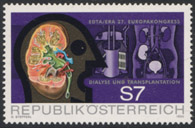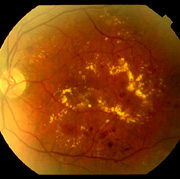




(click the retinal picture for an enlarged view)
Several risk factors exist for the development and the progression of
retinopathy. These include pregnancy, puberty, hypertension,
hyperlipidaemia and retinal disease. In addition, the duration fo diabetes
and inadequate control of hyperglycaemia are established predictive
factors for the development of retinopathy.
.
|
.
3.1 Duration of diabetes.
There is a clear correlation between the duration of diabetes and
the development of retinopathy16. Older patients have greater risk of
visual impairment mostly due to maculopathy17.
.
3.2 Control of diabetes
Prospective study of tight glycaemic control vs conventional control
clearly demonstrated the greater risk of progression of retinopathy in
both IDDM and NIDDM18, 18b.
.
3.3 Hypertension
Hypertension and pregnancy constitute two of the ‘second events’
which are associated with worsening retinopathy and particularly
the development of 19-21. Hypertension is a greater
risk factor in IDDM but is also important in NIDDM.
.
3.4 Pregnancy
Although most pregnancy patients with BDR will not experience a
worsening of their retinopathy during pregnancy, a small and
predominantly unpredictable cohort of patients will progress rapidly
to neovascularisation22-24. Predictive factors are poor pre-pregnancy
control of diabetes, too rapid tightening of control during the early
stages of pregnancy and the development of complications during
pregnancy such as pre-eclampsia and fluid imbalance.
..
3.5 Renal disease
Patients with end-stage renal failure almost invariably develop
worsening of their retinopathy, both affecting the macular (retinal
oedema) and the development of new vessels. Conversely treatment
to the renal disease may be associated with an improvement tin the
retinopathy and a more beneficial response to treatment, as seen for
instance after renal transplantation. patients with early nephropathy,
as determined by the presence of micro-albuminuria, invariably have
a rise in blood pressure further adding to the risk of retinopathy.
.
3.6 Hyperlipidaemia
Overweight and particularly obese individuals with hyperlipidaemia are
prone to florid exudative maculopathy. Hyperlipidaemia in the absence
of obesity is also a risk factor for severe exudative maculopathy
(Figure 22). The WESDR demonstrated a correlation between serum
cholesterol and risk of retinopathy in the diabetic population generally25.
Cigarette smoking may also be a significant risk factor for diabetic retinal
microvascular disease in men.

Figure 22 Florid exudative diabetic retinopathy. (Click picture for a larger view) |